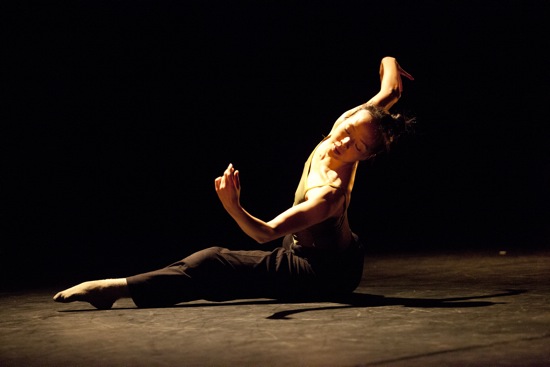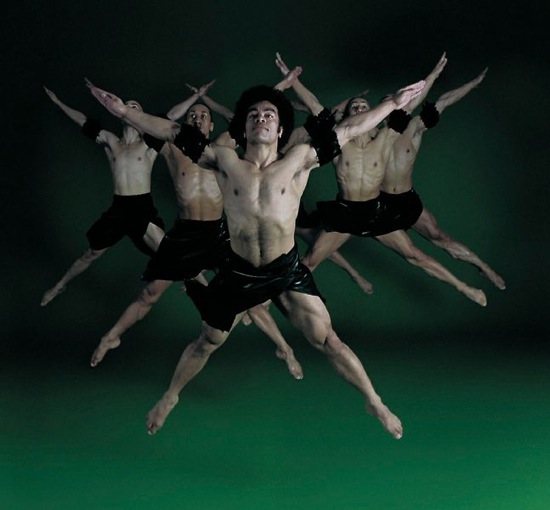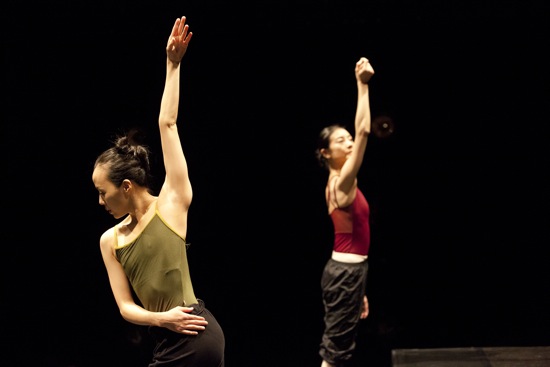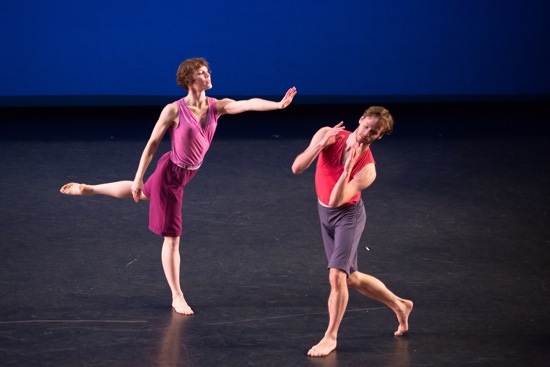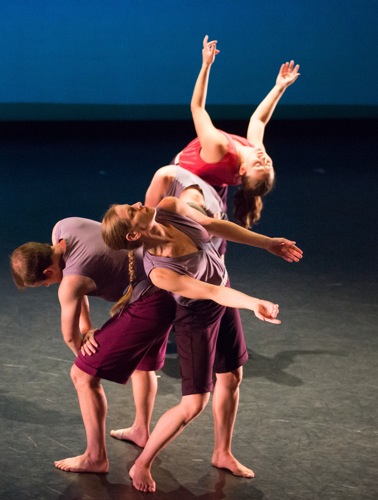The Fall for Dance Festival returns to New York’s City Center Theater, October 8-19.
It’s time to Fall for Dance again. The so-named City Center Festival now in its eleventh year continues its admirable message to expose New Yorkers and visitors to a wide range of dance companies via adroitly mixed bills. For $15 a ticket, spectators can explore territory that’s new to them. You’re a fan of Rennie Harris Pure Movement? Take a look at the Australian Ballet as well, plus Brian Brooks Moving Company and Ballets Jazz de Montreal. Is Sara Mearns of the New York City Ballet a favorite of yours? You can encounter her new small ensemble surrounded by the Johannesburg-based Vuyani Dance Theatre, the Trisha Brown Dance Company, and the National Ballet of China. (And who knows how many productive friendships may be forming backstage?)
Program One is equally transnational and crosscultural, from its startling opening by New Zealand’s Black Grace and its conclusion with a new work by New York’s Mark Morris Dance Group (commissioned by Fall for Dance). Black Grace is a contemporary dance company, but many of its works draw on the background of its artistic director, Neil Ieremia, in both Samoan and Maori culture. The linked dances Minoi (1999) and Pati Pati (2009) create a powerfully tribal atmosphere. We hear men’s voices chanting before the curtain opens to reveal the singers, clumped together in a pyramidal formation and facing us head on. Bare-chested, with black fabric draped and wrapped around their loins, they stand rooted, feet apart.
Their display of power and unity is a sock in the gut. Choreographer Ieremia separates unison voices chanting Maori words into harmony and then into a contrapuntal rhythmic counting, with dancer Sean MacDonald acting as an understated leader. Gradually they add arm movements (one of them suggests a gathering in), bend forward, change focus, then built to stamping and body-slapping (the music, “Minoi Minoi” is traditional, arranged by Ieremia). These energetic rhythmic motions also separate from unison into counterpoint and back again. Individuals drop feed into patterns or initiate new ones.. When they move from their center-stage spot, traveling as a tight group, they increase in speed to an intoxicating degree.
The slightly less cohesive Pati Pati begins with three of the group’s women seated cross-legged in red light (by Nik Janiurek). They punch the floor to one side of them, then the other, smacking their own thighs in between. Before long, they’re on their feet and enmeshed with the men in a formation of seven that grows to one of nine. Pati Pati is an anthology of material drawn from the company’s repertory, and the music (by Ieremia and Juse) eventually ends, leaving only sounds the smack of hands on bodies and feet on floor. Here too, patterns split and come together, grow and shrink in increasingly fast and complex rhythmic interplay. As they take big steps across the floor, kick their legs at the air, and wheel their arms around, the dancers never decline in vigor and clarity.
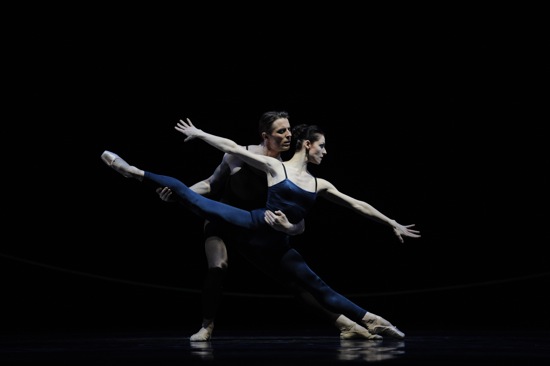
Sofiane Sylve and Luke Ingham of the San Francisco Ballet in Hans van Manen’s Variations for Two Couples. Photo: Eric Tomasson
Clarity is also a characteristic of Hans van Manen’s Variations for Two Couples, danced by four stellar members of the San Francisco Ballet. Strength, however, is de-emphasized. We understand it as a necessity, but in these traditional, post-classical pas de deux everything has to look easy. The setting is striking, if enigmatic. Designer Keso Dekker has strung a white rope almost all the way across the back of the stage, where it hangs looped, like a very long, waiting jump rope.
The opening selection of music, the Andante from Benjamin Britten’s String Quartet in F, briefly introduces two couples. Both men Carlos Quenedit and Luke Ingham cross the stage bearing their partners, Vanessa Zahorian and Sofiane Sylve, in mid-air leaps.
The widespread legs of those leaps recurs in the duet for Zahorian and Quenedit, whether she assumes the position in the air, or with toes on the ground, or while being dragged smoothly across the floor in an earthbound simulacrum of a leap. It seems to me that Sylve, partnered by Ingham, keeps her legs together more often—at least as much as a ballerina committed to arabesques and developpés can manage. Van Manen’s choreography is sleek standard stuff, and the women in their shiny unitards (red for Zahorian, royal blue for Sylve) look like gleaming fish as their partners turn and dip them and lift them high.
The two women are gorgeous and highly skilled, worthy of being displayed and handled in all the expected ways, and a few unexpected ones. Van Manen is not concerned here with challenging traditions; he moves from classicism and pointe work to go only as far as ballroom dance positions, Astor Piazzolla music, and faint allusions to tango. Also, in their second duet, Zahorian and Quenedit wobble their heads in response to something in the music (which also involves a selection by Einojuhani Rautavaara and an arrangement of an aria from a Bach cantata). Bobbleheaded dancers? What could van Manen have been thinking?
What’s curious about this performance (staged for the San Francisco Ballet by Rachel Beaujean) is the lack of connection between partners. That is, they are intimately joined by the difficult maneuvers they perform together, but they don’t project an awareness of themselves as loving collaborators in a dance relationship. The choreography requires the two men (whom I’ve admired before in other ballets) to show off the women as a primary duty. The women, especially Sylve, refer to their partners and appear pleased by what they can accomplish together, but Ingham and Quenedit behave like men with an exacting job to do—a job that excites them about as much as using a wrench on a leaky faucet. When not called to action, they assume faux-prince hauteur. A curious effect.
Another fine San Francisco Ballet principal dancer, Yuan Yuan Tan, moves beyond her comfort zone in Two x Two, a minimal, atmospheric 2009 work by Russell Maliphant, of Russell Maliphant/Sadler’s Wells London. The duet pairs her with Fang-Yi Sheu, a superb performer, remembered for her dancing in the repertory of the Martha Graham Dance Company. Michael Hull’s lighting isolates the two women: Tan in a far corner of the stage, Sheu diagonally opposite her. Andy Cowton’s score initially situates them in a spare, mysterious place with distant twinkles of sound and echoing, die-away tones occasionally pitting the silence.
From where I’m sitting, I can’t see Sheu at first, but instead watch Tan making simple gestures of reaching out, bowing down, arching her supple spine. Her focus is mostly inward, but she senses the space around her. While Tan is standing, Sheu is on the floor, but as she awakens to movement, she too reaches out, and her gestures are often synchronized with Tan’s —just at a lower level; occasionally she rises into a deep lunge, but usually sinks down again.
The music utters a low tone over a rumble and eventually a drumset beats out a strong rhythm. But the two women remain unhurried, as if experiencing separate variants of the same dream. Powered by a strength from deep within, their gestures unfold, becoming more lyrical—almost fragile—as they reach their apogee. The contrast between the women—Sheu earthy, Tan airier—is lessened in this strange connection. They never acknowledge each other, yet are bound together.
When the curtain rises on Morris’s Words, two dancers stand onstage facing each other; they hold between them a medium-sized, white-ish rectangle bordered in black. I have a few seconds of culture shock. Just so, traditionally, do two assistants wait at a performance of a dance-drama in the Kathakali style of South India; when they remove the “curtain,” it is to reveal an elaborately costumed costumed dancer and to signal the actions to come. In Words, the two performers “travel” the curtain offstage, revealing Laurel Lynch and Billy Smith prepared to dance to the first of ten selections from the eight books that make up Felix Mendelssohn’s richly lovely piano cycle, Songs Without Words. Some of these pieces were arranged for violin and piano, and Georgy Valtchev stands ready to join Colin Fowler on piano.
The curtain also has a vaudevillian edge—and a utilitarian one. Words is a blithe, swift-moving piece that is full of appearances and disappearances. Performers walk onto the stage, look around, and leave. They dance for a few seconds near the wings, as Michelle Yard does once, and then think better of staying. They race through on unknown errands. And often, they enter behind the portable curtain and are dropped off, while others may be picked up and shielded on their offstage journey. Now you see them, ladies and gentlemen, now you don’t. When I read that Morris plans to split his cast in two and send them touring in different directions, I thought, “perfect, this piece can be adapted to any number of people.”
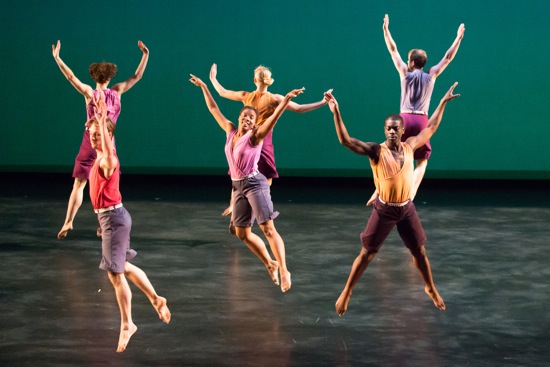
Mark Morris’s Words. (L to R foreground: Billy Smith, Michelle Yard, Brandon Randolph. (L to R rear): Laurel Lynch, Lesley Garrison, Noah Vinson. Photo: Ani Collier
This is an outdoor dance, it seems to me, with its sky-blue backcloth and mostly sunny lighting by Nick Kolin. Company dancer Maile Okamura has designed sporty, bi-colored costumes in autumn colors—knee-length pants and loosely draped shirts. Come to the picnic, or stop by and have a cup of punch. Lynch and Smith set the tone, dancing side by side; the movement has an easy-going air, with a hint of a saucy hip swing. When they’ve finished, they make a little gesture in front of themselves, as if wiping an imaginary window between us and them.
Alliances like these form and dissipate. To the measured music of Op. 67, No. 5 (sometimes dubbed “The Shepherd’s Complaint”), Jenn Weddel and Dallas McMurray dance for a while back to back, then turn to face each other, but remain separate. And the musical selections—some of them very brief—keep changing the climate. It’s Op. 67, No. 4, I believe, that induces some happy skipping (there goes Rita Donohue leaping) and people spinning in place with tiny steps the way a kid bent on getting dizzy might do.
Some of the musical selections that others than Mendelssohn have labeled as barcarolles rock and swing, and people pair up (gender blind at times). Op. 62, No. 3 introduces a martial vigor (da-dada DUM!) into which Noah Vinson is “dropped” to join Weddel, McMurray, and a small squadron that advances toward the audience. Weddel and Vinson are left alone as the march ends, and when the familiar rippling Mendelssohn piece, known to many as his “Spring Song,” begins, pairs run in to join exuberant swing-your-partner patterns. Donohue and Domingo Estrada, Jr. have a few breezy moments together to the following musical piece. When the music turns faster and more restless, Morris pits two temporary trios against other activities. Three people, shoulder to shoulder, each with one arm thrown around a neighbor’s neck, juts the elbow of his/her other arm forward as they dance; those neighboring elbows create an indescribably curious design.
Morris’s wonderful dancers swim into prominence, then spend time offstage, then swarm on. Aaron Loux, Sam Black, Lesley Garrison, Chelsea Acree, Lauren Grant, Stacy Martorana, Brian Lawson, and apprentice Brandon Rudolph, in addition to those mentioned. Here they pair up, there they go it alone; see a couple, make it a trio; leave a quintet, make it a foursome. It’s a sweet occasion, rife with bounding, swinging steps, a few pauses for reflection or observation, and an occasional fall or gesture that raises a question about just how wordless this musical day is.

